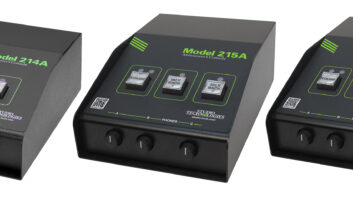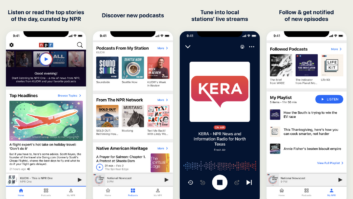With commuting times and traffic congestion on the increase in most urban areas, the time that we spend in automobiles becomes more important.
Radio has long been an important ally in making the ride home more bearable. In fact, the Consumer Electronics Association says that 75 percent of our in-car listening is done to AM or FM, as opposed to CDs or other media.
But radio’s listening time may soon decrease, as alternative mobile entertainment choices compete for commuters’ ears.
Cassette and CD players have long been available. Now they are being joined by mobile MP3 devices and, soon, satellite digital radio receivers.
As reported in the Feb. 14 issue of RW, the 2001 International Consumer Electronics Show highlighted innovative devices aimed at consumers in the car listening environment.
Have broadcasters taken the mobile audience for granted? If so, what should they do now?
Listen up
While there are no sure-fire strategies to combat these potential incursions, some industry leaders have begin to think seriously about the problem.
John Caracciolo, vice president and general manager of Long Island’s WLIR-AM-FM, notes that broadcasters often are too slow in their response to new technologies.
“Radio stations that put their heads in the sand are going to get buried. One strategy to respond to MP3 car stereos and satellite broadcasting is localism,” he said. “This means not only paying more attention to local news, but also giving exposure to local music and local musicians.”
Becoming a provider of unique MP3 content may be a way for stations to capture some of the mobile MP3 audience. Localized versions of hit songs, material by local artists and special programming all may be served to the listener through the station’s Web site.
Creative uses of the RDS subcarrier are also a possibility, although RDS has not been a sweeping success in the United States.
But the hardware is out there. For instance, Jay Brentlinger, president of Circuit Research Labs, said his company includes Radio Data System capability in the digital software of CRL and Orban products. He said the alternate frequency function of RDS, which can switch the receiver to a station’s translators, and the traffic alert function, which activates the receiver for traffic bulletins, can be used to promote drive-time listening.
Also, billboards that display a station’s current song and artist can be effective promotions to grab a mobile audience, although anecdotal evidence suggests that the RDS billboard strategy has enjoyed only spotty successes since the early days of RDS.
No pickets
Long-term technical strategies to combat audience erosion also may need to be considered.
FM stereo reception is still plagued by multipath interference, particularly in urban areas. Eric Small, CEO of Modulation Sciences Inc., said one proven solution to the problem is diversity reception, in which two antennas are used; the receiver automatically selects the one with the best signal.
The technique, common in wireless microphone systems, could also be applied more widely to radio receivers.
“Diversity reception has been used in the European mobile market for the past 10 years, and the improvement in reception is staggering,” Small said.
“Some would object to the aesthetics of two antennas, but auto manufacturers have been pretty clever about hiding the second aerial.”
On the floor
New consumer electronics devices have always been a part of radio’s competitive environment. This year’s batch, as seen at the CES show, is dominated by MP3 players and preproduction satellite digital radio receivers. Major consumer manufacturers are battling to win the ears of listeners on the move.
For instance, Delphi demonstrated new technologies that it hopes will make mobile MP3 players easier to use.
Conventional units require that the user burn CDs with MP3 files, or remove the player from the car and download files from a home computer. But by using the wireless local area network standard IEEE 802.11b, licensed audio files and other data could be transmitted at speeds of up to 11 MB over a range of 300 feet.
A collaborative project of Delphi and 3Com Corp., the prototype network operates in the 2.4 GHz band.
Delphi Delco Electronics also will be shipping XM and Sirius Satellite Radio receivers to various automakers.
Another example is Empeg, one of the first companies to manufacture MP3 car radios. It recently was acquired by Rio. The second-generation Empeg car player uses laptop hard drives as its storage medium. These ruggedized drives, combined with sophisticated caching, promise glitch-free listening even on rough terrain.
For loading new music, the player pulls out of its sled and connects to a home computer via USB or Ethernet connectors. The player works with either Windows or Linux software.
Empeg will soon support Windows Media Audio (WMA), which has smaller audio files, enabling more songs to be stored on the hard drive. Another benefit to the removable receiver is that you can connect it to your home stereo and continue listening where you left off in the car.
The Empeg box runs on the Linux operating system. Computer-savvy users can customize the player to their tastes, and add other Linux applications.
The entry-level model has 6 GB of storage, providing 100 hours of music. The 40 GB model holds more than 680 hours of music.
Options include an AM-FM tuner with RDS/RDBS. List prices start at $1,199.
As reported on page 1 of this issue, satellite digital radio is expected to launch sometime this summer. Numerous exhibitors at CES displayed their entries in this marketplace. The preproduction models include head units that are satellite-ready; plug-and-play tuner modules that plug into a consumer’s existing head unit; and multimedia systems that incorporate satellite tuning.
Whether from MP3, satellite radio or future wireless Internet technologies, it is clear that conventional broadcast media will have more competition, and may need to devise strategies to cope with the alternative media finding their way into listeners’ vehicles.












